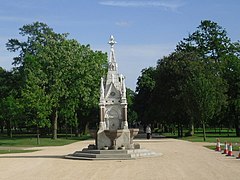
Sir Cowasji Jehangir Readymoney, CSI was a Parsi community leader, philanthropist and industrialist of Bombay, India.

The Buxton Memorial Fountain is a memorial and drinking fountain in London, the United Kingdom, that commemorates the emancipation of slaves in the British Empire in 1834, and in particular, the role of British parliamentarians in the abolition campaign.

The Metropolitan Drinking Fountain and Cattle Trough Association is an association that was set up in London by Samuel Gurney, a member of Parliament and philanthropist, and Edward Thomas Wakefield, a barrister, in 1859 to provide free drinking water.
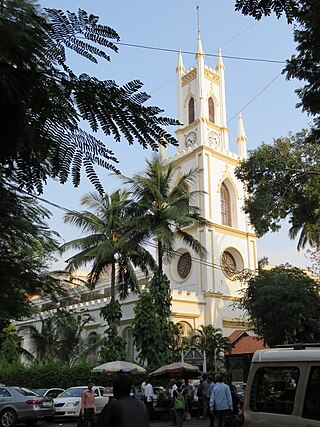
St. Thomas Cathedral, Mumbai, is the 300-year old cathedral church of the Anglican Diocese of Mumbai of the Church of North India. It is named in honour of Saint Thomas the Apostle, who is believed to have first brought Christianity to India. The cathedral is located in Horniman Circle, the historic centre of Mumbai. It is in close proximity to famous Mumbai landmarks such as Flora Fountain and Bombay House. It is the oldest church in Mumbai The Cathedral and John Connon School is run by the cathedral.

Mowbray Park is a municipal park in the centre of Sunderland, Tyne and Wear, England, located a few hundred yards from the busy thoroughfares of Holmeside and Fawcett Street and bordered by Sunderland Museum and Winter Gardens to the north, Burdon Road to the west, Toward Road to the east and Park Road to the south. The park was voted best in Britain in 2008.
The architecture of Mumbai blends Gothic, Victorian, Art Deco, Indo-Saracenic & Contemporary architectural styles. Many buildings, structures and historical monuments remain from the colonial era. Mumbai, after Miami, has the second largest number of Art Deco buildings in the world.

The Fontana delle Tartarughe is a fountain of the late Italian Renaissance, located in Piazza Mattei, in the Sant'Angelo district of Rome, Italy. It was built between 1580 and 1588 by the architect Giacomo della Porta and the sculptor Taddeo Landini. The bronze turtles around the upper basin, usually attributed either to Gian Lorenzo Bernini or Andrea Sacchi, were added in either 1658 or 1659 when the fountain was restored.
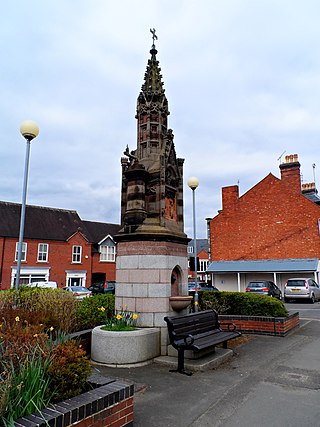
The Churton Memorial Fountain stands on the west side of Brownlow Street, Whitchurch, Shropshire, England. It is recorded in the National Heritage List for England as a designated Grade II listed building.
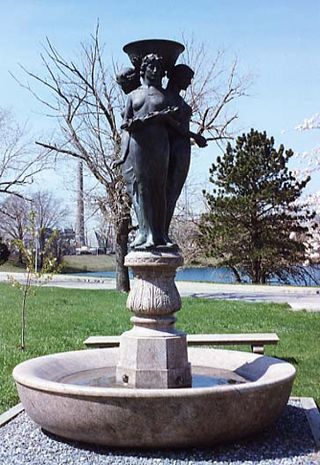
The McMillan Fountain is a public artwork by American artist Herbert Adams located on the McMillan Reservoir grounds. The fountain, completed in 1912 and dedicated in October 1919, consists of a sculptural group of the Three Graces placed upon a pink granite base. Cast by Roman Bronze Works, the fountain was originally part of a large landscape setting designed by Charles A. Platt. The fountain currently resides near its original location at McMillan Reservoir in the Bloomingdale neighborhood of Washington, D.C.
This is a history and list of drinking fountains in the United States. A drinking fountain, also called a water fountain or bubbler, is a fountain designed to provide drinking water. It consists of a basin with either continuously running water or a tap. The drinker bends down to the stream of water and swallows water directly from the stream. Drinking water fountains are most commonly found in heavy usage areas like public amenities, schools, airports, and museums.
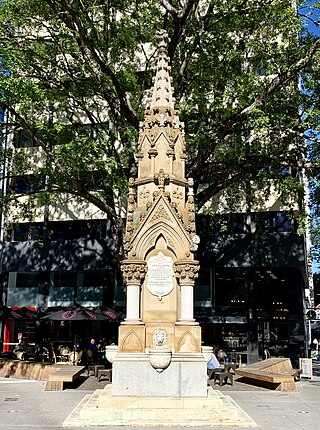
Mooney Memorial Fountain is a heritage-listed memorial at 118 Eagle Street, Brisbane City, City of Brisbane, Queensland, Australia. It was designed by William Holloway Chambers and built from 1878 to 1880 by William Webster. It is also known as Eagle Street Fountain. It was added to the Queensland Heritage Register on 21 October 1992.
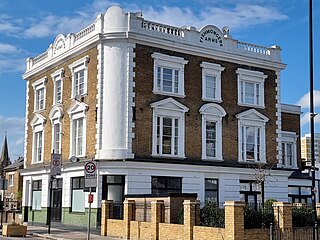
The Fishmongers Arms is a former public house in Wood Green in the London Borough of Haringey. Built in 1855 on the site of the former Wood Green Farm, Its name derived from the adjacent Fishmongers' and Poulterers' Almshouses, which were demolished in 1956 for the construction of the Haringey Civic Centre.

The Matilda Fountain is a Grade II listed statue and drinking fountain opposite 15 Gloucester Gate, Regent's Park, London, built in about 1878.

The Albert Clock is a clocktower memorial in Barnstaple in Devon to Albert, Prince Consort, the husband of Queen Victoria. It has been listed Grade II on the National Heritage List for England since 1988.

Yerevan 2800th Anniversary Park, also known as the Vardanyan's park, was opened on 10 May 2019. The park is a gift from Mikayel and Karen Vardanyan on the 2800th anniversary of the foundation of Yerevan city.
The Prince of Wales Obelisk in Port Elizabeth, South Africa, was erected in honor of the marriage of Prince Albert of Wales, later King Edward VII of the United Kingdom, and Alexandra of Denmark but not originally intended for them. It is thus one of the only "second-hand" royal monuments in the world. It was originally purchased for the grave of George Kemp. It was later moved in front of the Bayworld museum complex. The monument is a simple obelisk carved out of an igneous rock similar to granite.

The Convocation Hall or Cowasji Jehangir Convocation Hall at the University of Mumbai is part of the Victorian buildings complex around the Oval Maidan in Mumbai that is a UNESCO World Heritage Site. It was built between 1869 and 1874, and designed by Sir George Gilbert Scott, who incidentally never visited Bombay and worked from London.

Public drinking fountains in Philadelphia, Pennsylvania, United States, have been built and used since the 19th century. Various reform-minded organizations in the city supported public drinking fountains as street furniture for different but overlapping reasons. One was the general promotion of public health, in an era of poor water and typhoid fever. Leaders of the temperance movement such as the Woman's Christian Temperance Union saw free, clean water as a crucial alternative to beer. Emerging animal welfare organizations, notably the Society for the Prevention of Cruelty to Animals, wanted to provide water to the dogs and working horses of the city on humanitarian grounds, which is why Philadelphia's drinking fountains of the era often include curb-level troughs that animals could reach.


